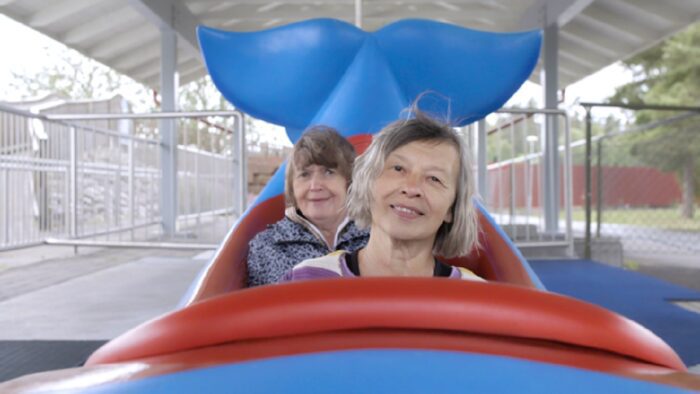Featured at the 2023 Tribeca Film Festival in the documentary program, The Gullspång Miracle starts out innocuously enough. May and Kari are two sisters—both of whom went on a whale-themed water ride that injured the former’s tailbone and led to both of them going real estate shopping in order to fill the time left behind with May’s recovery—with a covert objective of searching for a very particular type of still life art. Lo and behold, they find exactly what they’re looking for in one of the apartments, a large still life of fruit that May interprets as a divinely answered prayer, and that Kari interprets via its placement between two other paintings like it as a symbolic Trinity.
With both of them fully convinced of the still life’s divine orientation, they visit Olaug, the person who owns the apartment—only to discover that she’s the spitting image of May and Kari’s late sister Astrid, affectionally referred to as Lita, who took her own life decades prior. The reason for the identical appearance? Olaug turns out to be Lita’s twin, making her May and Kari’s half-sister. As Maria Fredrikkson’s documentary about the events, The Gullspång Miracle, only continues the story onward from there. The revelations and shifting family dynamics that unfurl reveal a chasm of pain and trauma behind this newfound family bond, with each twist and turn more surprising than the last.
Much of The Gullspång Miracle works with Fredrikkson as the audience’s surrogate, following her as she grows to uncover and learn more and more about the dimensions of this family while they grapple with the newfound realization that Olaug is related to them. The opening moments of the documentary are structured in a typical way, although something about them is somewhat different. Kari and May guide the audience through the situation in which they found the pivotal still life that led them to Olaug. However, it’s within the context of a scene that Fredrikkson directs in takes that she leaves in the final product, in which she advises the two to talk more technically rather than acting out the moment itself.
Talking-head interviews are also somewhat prevalent towards the opening portions of the film, which is a necessity for the story’s more expositional initial moments. That aside, the revelations of Kari, May, and Olaug’s story demand a structure that is able to keep up with them as they reveal more and more about the latter’s place in the family. The Gullspång Miracle moves further and further into capturing on-the-scene footage of what those revelations look like, and the direct emotional impact they have on everyone involved in both the family and their periphery.
One of the most pivotal pieces of information in The Gullspång Miracle we learn about Olaug early on is the reason for her disconnect from Kari and May’s family being born as twins in occupied Norway during the Second World War even after they learn about her relation to Lita. The existence was bound to draw the attention of the Nazis’ experimentation campaigns, and as a ploy to avoid that possibility entirely, Olaug was sent away. Meanwhile, on the angle that Lita’s story provides to this narrative, it is also one of the circumstances surrounding her death—one that was always known to be a suicide by the entire, emotionally torn, and strictly Christian family who deemed Lita a sinner for her actions. These two elements alone are most likely enough to sustain the entire film. It proves, even, to be a binding force emotionally, as Olaug describes having felt a sense of vague, intangible loss similar to what Kari and May knew Lita experienced not long before she took her own life.

Nevertheless, the aforementioned facets of the family’s strict Christian beliefs, Olaug’s determination to get to the bottom of the inexplicable details of Lita’s death, as well as further complications that arise and throw several wrenches into the assumed course of this story, all give the impression that the miracle of the film’s opening moments may have been far less of a stroke of serendipity than initially anticipated. Each reveal and reversal of every single detail that gets established beforehand proves to be more traumatic than the last.
The effects it has on the family are pronounced, enough for them to be relatively split on what exactly Olaug is bringing to the table, and whether or not her presence, as well as her more secular values relative to the family’s deeply Christian upbringing, will grow to be a welcomed presence as the various revelations about Olaug and Lita begin to create escalating tension amid the family. The distress of these revelations are only further amplified by the fact that most of the main players in this family are in the later years of their lives. Every assumption about how they’ve lived so far is forced to be retroactively reassessed—a change they need to confront that hardly ever comes easily at any point in The Gullspång Miracle.
Interspersed throughout this film are several shots of a photo of Lita hung up on one of Kari’s walls—a memorial of sorts that frequently proves to be the grounding image of the film. In moments of heightened distress and in moments where our assumptions about her and Olaug are torn down drastically, The Gullspång Miracle chooses once again to return to such a visual, zooming in gradually as we hear the impact of that subversion on members of the family, directly into one of her eyes. What those eyes have seen, and the impact of the truth they obscure, will likely never be solved, and will always leave questions that remain unanswered.
The struggle this family is forced to overcome is how to reckon with the chasm of pain and trauma that seems to have created this miracle that seems to have brought them together so closely. The process that Fredrikkson captures throughout The Gullspång Miracle is both unique in how those turns come about, but also incredibly universal in how complicated the reactions to those turns inevitably become. Undoubtedly, it’s a heartwarming story about belonging, but what Fredrikkson captures alongside it is a deeply intriguing, harrowing tale of what emerges when that particular need clashes with our preconceived notions about the people we care about, and what we end up learning about them that we may have never truly expected.




